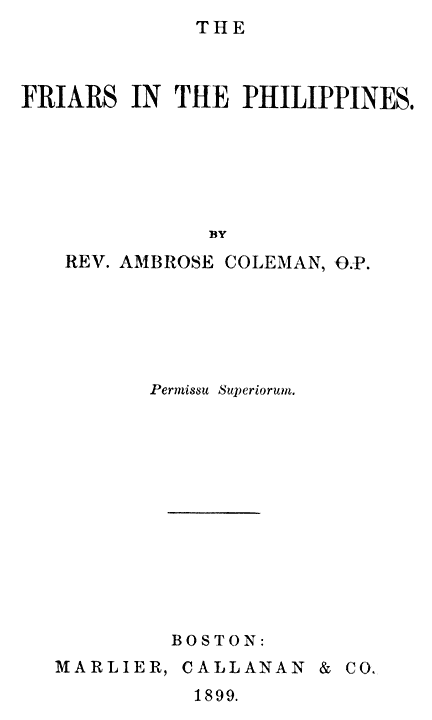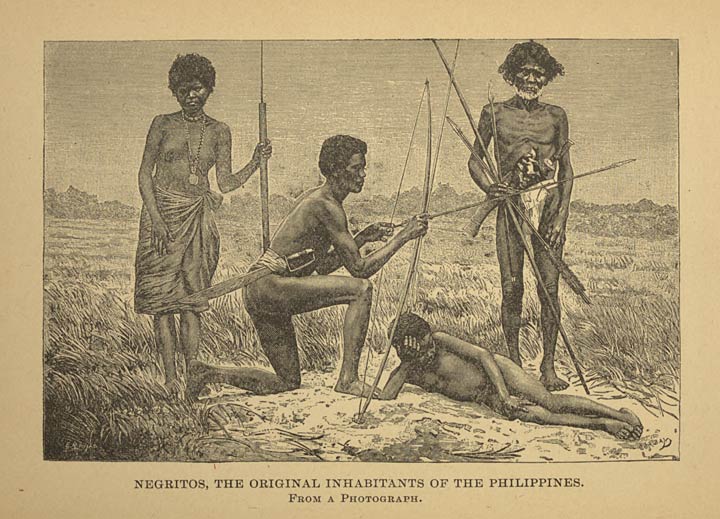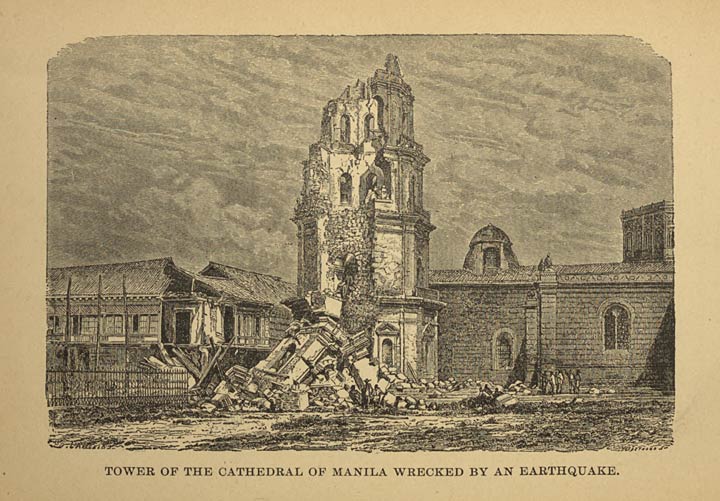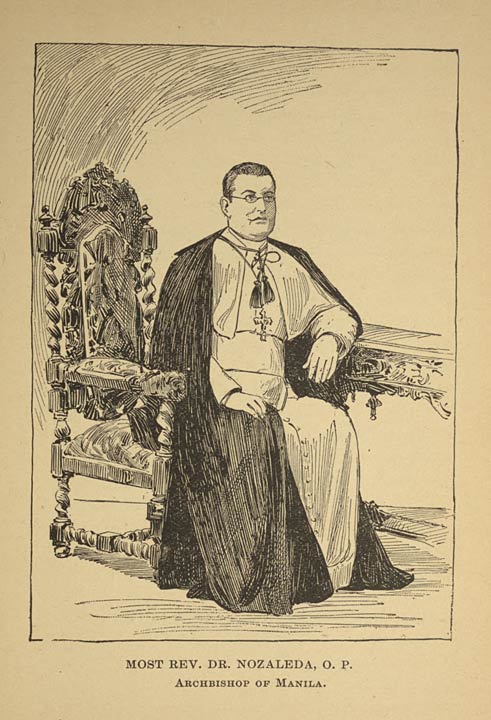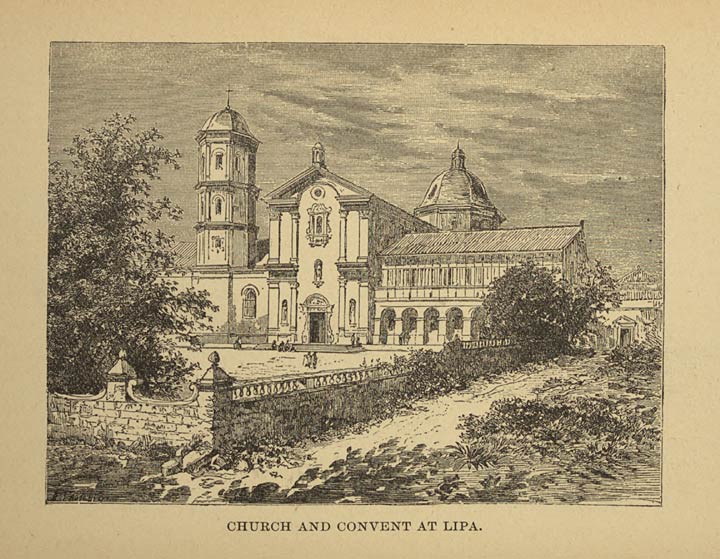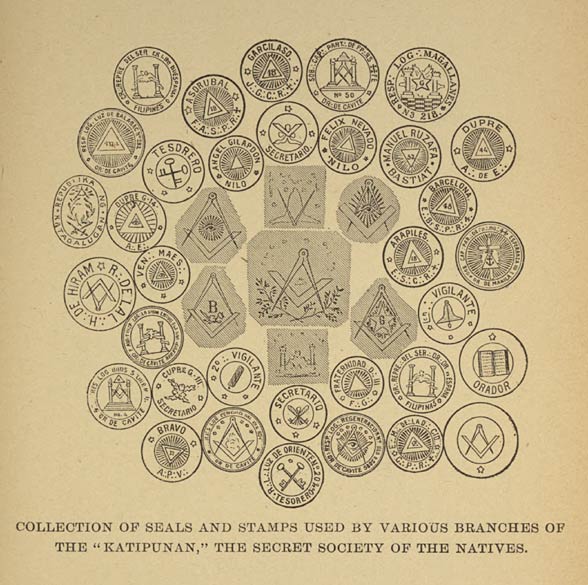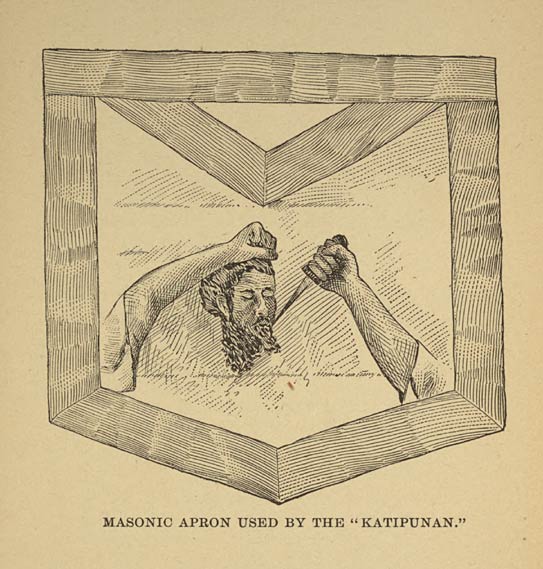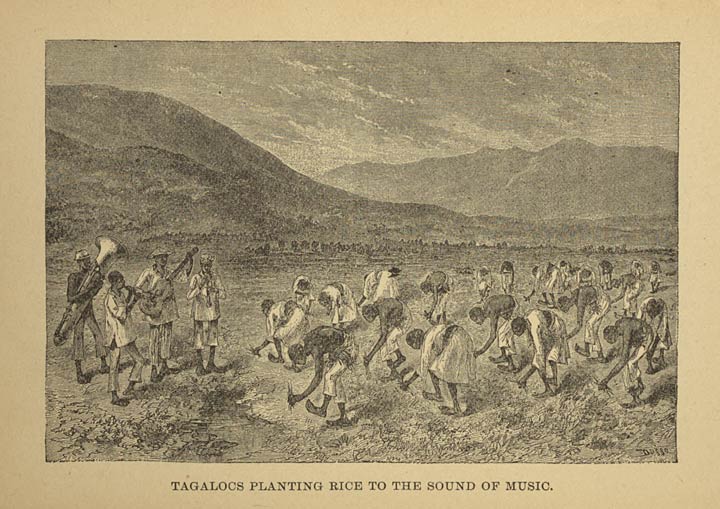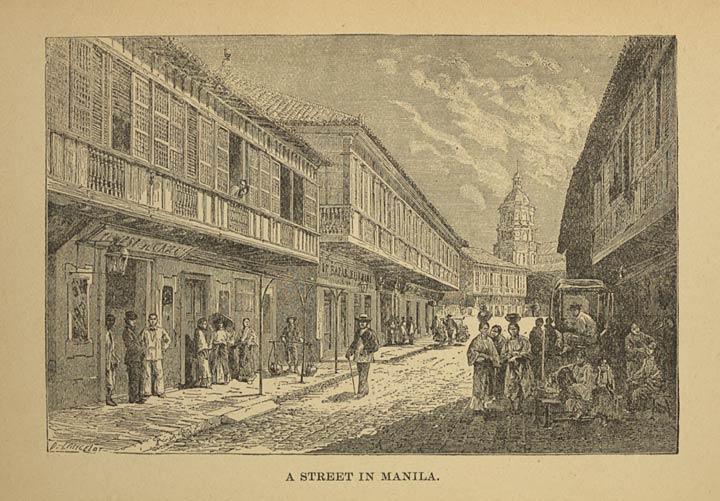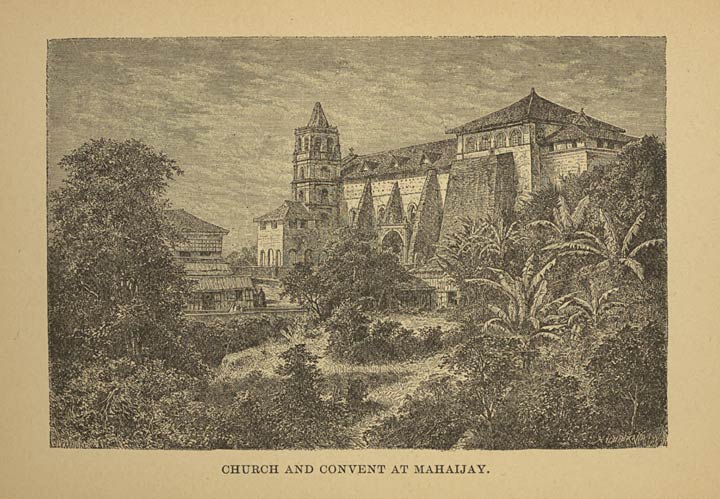A recent traveller designates the Philippines as the
birthplace of typhoons, the home of earthquakes,—epithets
undoubtedly strong yet well deserved; and typhoons at certain seasons
of the year, with earthquakes at uncertain periods, when taken together
with the torrid heat, trying at all seasons, and the malaria fruitful
of fevers, make these islands of the Eastern seas, which otherwise
would be a veritable Paradise upon earth, an undesirable place of abode
to the average European, unless, indeed, he is attracted thither by the
greed of gain or by the nobler desire of missionary enterprise.
For Nature, bountiful there almost to prodigality, revelling in all
the luxuriance of tropical [8]vegetation, has always at hand, as a
set-off to her gifts, terrible manifestations of her power. The
seventeenth-century navigator, William Dampier, in his own quaint and
amusing way, describes how the natives and the Spanish colonists of
Manila strove to guard against the double danger of earthquakes and
typhoons, and how they both failed ignominiously. The Spaniards built
strong stone houses, but the earthquake made light of them, and shook
them so violently that the terrified inmates would rush out of doors to
save their lives; while the natives from their frail bamboo dwellings,
which were perched on high poles, placidly contemplated their
discomfiture. All that the earthquake meant to them was a gentle
swaying from side to side. But the Spaniards had their turn when the
fierce typhoon blew, against which their thick walls were proof. Then,
from the security of their houses, could they view, with a certain grim
satisfaction, the huts of the natives swaying every minute more
violently in the wind, till, one by one, they toppled over—each
an indescribable heap of poles, mats, household utensils, and human
beings.
By way of general description it may be said that the Philippine
Archipelago consists of between one and two thousand islands; two of
which, Luzon and Mindanao, are much larger than Ireland, while the rest
vary in size down to mere islets, rocks, and reefs. Altogether the
islands [9]stretch from north to south a distance as great as
from the north of England to the south of Italy. The soil is extremely
rich, and easily cultivated; vast forests abound, containing valuable
timber; and the mineral resources, up to the present undeveloped, are
apt to prove a sure source of income under modern methods of
working.
But what concerns us most in this inquiry is the character of the
inhabitants. The population, which is variously estimated at from eight
to ten millions, is made up of more than eighty distinct tribes, which
nearly all belong to the Malay race. There are still to be found in
some of the islands, and principally in the mountainous districts, the
remnants of the aboriginal inhabitants, usually called Negritos. These
are of a distinctively inferior type, are rapidly diminishing in
numbers, and seem to many observers incapable of civilization. Our only
concern therefore is with the Malays, who form the vast bulk of the
population, and have in the course of time been nearly all converted to
Christianity. Nearly seven million Christians are counted among them;
while the unconverted pagans, together with the Moros, or Malay
Mohammedans, of Mindanao and the Sulu islands, are not a million in
number.
Christianity has effected a wonderful transformation in the
character of the people, softening and refining it, as we may judge by
the contrast presented by their cruel and bloodthirsty neighbors
[10]in Mindanao and the Sulu group, who, nevertheless,
belong to the same race, and whose characteristics they must originally
have shared. Travellers have not sufficiently dwelt on this important
point. They note that the civilized native is self-respecting and
self-constrained to a remarkable degree, patient under misfortune, and
forbearing under provocation. He is a kind father and a dutiful son.
His relatives are never left in want, but are welcome to share the best
his house affords, to the end of their days. Unfortunately for himself,
he is a happy-go-lucky fellow, delighting in cock-fighting and games of
chance, and naturally indolent, his wants being so few and simple. He
is a born musician, genial, sociable, loving to dance, sing, and make
merry among his companions. His wife is allowed a degree of liberty
hardly equalled in any other Eastern country, a liberty she rarely
abuses. She is the financier of the family, and the husband consults
her when making a bargain. She does her share of the work; but it is
not more than her just share, and she is not overburdened with labor.
Hospitality is cheerful and open-handed, and the traveller is welcomed
to the hut of the native with cordiality. The houses of the natives are
kept neat, and are models of cleanliness, and the natives also keep
themselves extremely clean. They are practical and fervent Catholics.
At the vesper Angelus bell “there is always a pretty scene. An
instant hush comes over the busy village. [11]In each house father,
mother, and children fall on their knees before the image or picture of
some saint, and repeat their prayers. The devotions over, each child
kisses the hand of his father and his mother, at the same time wishing
them good evening. He then makes an obeisance to each of his brothers
and sisters, as well as to each guest who happens to be present,
repeating his salutation with each funny bow. Host and hostess also
greet one in the same way; and in remote places, where white men are a
rarity, the little tots often kneel to kiss one’s hand.”
(“The Philippine Islands and their People,” by Dean C.
Worcester.)
In sharp contrast to the happy, contented, and peaceful character of
the Christian native, is his southern neighbor of the same blood, the
fanatical Moro. Mohammedanism has accentuated rather than softened the
underlying fierceness of the Malay; as it gives him a religious
sanction to cruelty, treachery, murder, pillage, and piracy when
directed against the hated Christian. Inhuman and cold-blooded cruelty
is the great characteristic of the Moro, who will calmly cut down a
slave merely to try the edge of a new weapon. For two centuries and a
half the Moros organized piratical expeditions against the northern
islands. The coming of the dreaded fleet of war-praus was looked
forward to as an annual event; and while the southwest monsoon was
blowing, vigilant sentinels were on the lookout night and day from the
watch-towers [12]with which every village was provided. The
introduction of modern artillery and quick-firing guns at last turned
the scales in favor of the Spaniards, and the piratical expeditions are
now a thing of the past. All Christians, however, living near the Moros
must still carry their lives in their hands, owing to the
juramentados. A juramentado is a man who takes an oath to
die killing Christians. The more Christians he kills, the higher place
of course he is to get in heaven, especially if he loses his own life
in the holy work. He dresses in white, shaves his eyebrows, conceals a
weapon under his clothing, and then seizing a favorable opportunity,
runs amuck, killing without mercy men, women, and children. Of course
he gets killed himself in the end, but sometimes not until he has made
himself accountable for a great number of deaths.
Though Magellan discovered the Archipelago in 1521, no serious
attempt to take possession of it was made till 1565, when an expedition
of four hundred soldiers and sailors was fitted out by Philip II., and
placed under the leadership of Miguel Lopez de Legaspi. As Philip was
inspired by religious zeal, and his principal and perhaps only object
was to spread the light of the Gospel, six Augustinian friars
accompanied the expedition. We may say with truth that it was these
missionaries, and the others who followed in rapid succession, who
conquered the Archipelago [13]for Spain. There was no conquest in
the strict sense of the term. The Spaniards in most places simply
showed themselves to the natives; and the religious, who accompanied
them, persuaded the untutored savages to submit to the King of Spain,
through whom they would obtain the two-fold blessing of civilization
and Christianity. The retention of these rich and fertile islands, so
great a source of revenue to the mother-country, was on the whole a
very easy task. The religious Orders planted themselves firmly in the
colony, and spread themselves everywhere, winning the natives to
Christ, keeping them also in loyal obedience to that great European
power by whose means the missionaries had been sent to them. They were
thus the real bulwarks of Spanish power there, which was kept up rather
by gentle persuasion than by force of arms. Mr. Mac Macking, a Scotch
Protestant who spent some years there, says: “The warriors who
gained them over to Spain were not their steel-clad chivalry, but the
soldiers of the Cross,—the priests who astonished and kindled
them by their enthusiasm in the cause of Christ.” Up to a few
years ago profound peace reigned; and a garrison of 4,200 soldiers,
3,500 gendarmerie, and 2,000 sailors and marines, was considered
sufficient to overawe a population of eight millions, besides keeping
in check the fanatical and bloodthirsty Moro pirates.
The Augustinians were the pioneers in religious [14]enterprise, coming, as we said already, with
Legaspi, in 1565, four years before the Philippines were formally
annexed to Spain. They were followed, in 1577, by the Franciscans; and
the labors of both Orders were so successful that Manila was erected
into an episcopal see in 1579. Two years later
Salazar, a Dominican friar laboring in Mexico, was appointed bishop;
and he brought the Dominicans with him to Manila. About the same time,
also, the Jesuits and the Recollects, or discalced Augustinians,
entered the country. All the Orders went about their work with truly
religious zeal; and their success was so great that at the end of the
century Mendoza could say: “According to the common opinion, at
this day there are converted and baptized more than four hundred
thousand souls.” It was a success to be proud of among a people
who, when the missionaries came, had no religious worship, nor temple,
nor priest, nor form of worship. They had but a hazy notion of a Deity,
their sole religious ideas consisting of some imperfect notions of a
hell and a heaven. Persecution only gave zest to the work, both in the
Philippines and in the Ladrones, of which we may speak together in this
connection, as they have a common history. Towards the close of the
sixteenth century, as we learn from Argensola, more than six thousand
Christians had already been martyred in the single province of Ternate,
“that so,” he adds, “the foundation of our faith may
be [15]in all parts cemented with the blood of the
faithful. They dismembered the bodies, and burned the legs and arms in
sight of the still living trunks. They impaled the women, and tore out
their bowels; children were torn piecemeal before their mothers’
eyes, and infants were rent from their wombs.” (“Discovery
and Conquest of the Molucca and Philippine islands,” by B. L. de
Argensola.) Opposition, and persecution too, came from the Mohammedan
element in the population, which was already formidable when the
Spaniards arrived on the scene, Mohammedanism having been introduced
into the islands, especially the more southerly group, as far back as
the thirteenth century. Accordingly the Mohammedans waged a long and
bitter warfare both against missionaries, and the new Christians,
numbers of whom were called on to seal their faith with their blood.
Still, in spite of persecution, the Church prospered in those early
days. Dampier, the English navigator, who visited the Philippines
towards the close of the seventeenth century, testifies to the
wonderful progress made even then in civilization. “In every
village,” he says, “is a stone church, as well as a
parsonage-house for the rector, who is always one of the monks. These
last, who are all Europeans, are very much respected by the Indians,
while the secular clergy, who commonly are Creoles, are held in
contempt. Hence the Government shows great deference to the rectors;
for, generally speaking, [16]the Indians always consult them on
entering on any enterprise, or even as to paying taxes.” Thus,
one century had changed the people from savagery to civilization. In
Manila, Dampier found the natives pursuing all the avocations of
civilized life—they were merchants, skilled artisans in various
trades, clerks, etc.
There were three large colleges,—two under the care of the
Dominicans, and one carried on by the Augustinians. There was also a
Poor Clare convent, containing forty nuns, together with a hospital and
an orphanage. The religious establishments occupied one-third of the
city as it then stood. This may seem out of proportion to the religious
needs of the city; but we must remember that in Manila, then as now,
priests of the various Orders were in training for the numerous
missions of the Archipelago, Tonkin, and China (see Appendix I.), and,
at the period of which we are speaking, of Japan as well.
Passing on to the present century, the Rev. David Abeel, a
Protestant missionary, says of the Philippines: “The Church of
Rome has here proselytized to itself the entire population. The
influence of the priests is unbounded.” In the year 1858 Mr.
Crawford, who was formerly governor of Singapore, made the following
declaration at a public missionary meeting: “In the Philippine
Islands the Spaniards have converted several millions of people to the
Roman Catholic faith, [17]and an immense improvement in their social
condition has been the consequence.” Mr. MacMacking confesses
that the suppression of the Jesuits, who were banished from the
Philippines in 1768, “was attended with the worst effects to the
trade and agriculture of the islands.” He adds that
“religious processions are as frequently passing through the
streets as they are in the Roman Catholic countries of Europe.”
He testifies that “the Church has long proved to be, on the
whole, by much the most cheap and efficacious instrument of good
government and order—even the common people learn reading by its
aid, so much at least as to enable them to read their prayer-books and
other religious manuals. There are very few Indians who are unable to
read, and I have always observed that the Manila men serving on board
ships and forming their crew have been much oftener able to subscribe
their names to the ship’s articles than the British seamen on
board the same vessels could do.” Prosessor Ferdinand
Blumentritt, a German Protestant, who is universally acknowledged to be
the most competent authority on all that regards the Philippines, spoke
most highly of the missionary and scientific work of the Religious
Orders there, at a meeting of the Vienna Geographical Society in 1896.
The weight of testimony from such a source all must acknowledge; it is
indeed a pleasure to present the German scientist’s remarks to
the consideration of fair-minded readers. [18]
“I wish to add some remarks,” said Blumentritt,
“about the Philippines, as here the Catholic missionaries are
usually active not only in the spread of Christianity and its
civilization, but also in the geographical and ethnographical
exploration of the archipelago. Unfortunately the reports of the
missions of the various Orders are not equally accessible, e.g., we
have very little account of the Augustinian missions, which are located
principally in the lands of the Igorrotes (Northwest Luzon) and on the
Island of Negros, among the Budkidnon savages. The only important
publication upon Augustinian missions which I have been able to see is
the Memoria acerea de las Missiones de los P. P.
Augustinos Calzados, Madrid, 1892. According to this the Calced
Augustinians in 1892 had in the province of Abra, among the Tinguians,
who inhabit it, eight missions with 25,100 souls; in that of Lepanto,
two missions with 2,200 souls (Igorrotes); in that of Bengnet, also two
missions, with 849 souls (Igorrotes)—total, 28,149 souls, as
against 5,302 in 1829. Between 1874 and 1885 the number of savages and
heathens converted to Christianity was 1,356; from 1885 to 1888 there
were 549. In 1892 the erection of 15 new missions was projected in the
provinces of Tiagan, Bontok, Amburayan, and Quiangan.
“The Discalced Augustinians, called in the Philippines
‘Recoletos,’ have missions in the Island of Palawan (or
Paragua) and in the group [19]of the Calamianes. Of these
missioners, Father Cipriano Navarro has especially distinguished
himself by his ethnographical researches; and we owe to him exhaustive
reports concerning the Tinitians, Togbanuas, Tandolans, and
Bulalacaunos, among whom Christianity is making steady progress.
“The Franciscans have missions in the peninsula of Camarines,
in Luzon, and in every large island on the Pacific coast. Ethnography
and philology are much indebted to their labors. I need only refer to
the works published by myself in the proceedings of our Society, the
vocabulary of the Negrito dialect of Baler by Father Fernandez, and the
accounts of the Bikols, Dumagats, and Atas, by Father Castano.
“We possess fuller accounts of the Dominicans, who are
occupied in converting to Christianity the Alimis, Apayaos, Aripas,
Buayas, Bumanguis, Bungians, Calauas, Calingas, Catalangans, Dadayags,
Gaddans, Ibibalons, Ibilaos, and Ilongotes, Ipiutys, Isinays, Mayoyaos,
Guiangans, and other Ifuagao races. In the missionary review, Correo
Sino-Anamito, we find numerous descriptions of popular manners and
customs. Some of these, particularly those written by Fathers
Villaverde, Buenaventura, Campa, Malumbres, Ruis, and Ferrando, I have
already in part made more generally known in these proceedings. The
review also publishes occasional sketches, and especially such
[20]as throw light on the river-system of North Luzon,
the valley of the Rio Grande de Cagayan. The results of their strictly
missionary labors are very fruitful.
“But however successful the evangelical and scientific
activity of the missionaries of the above Orders, they are far
surpassed by what the Jesuits have done in the island of Mindanaoin, in
half a generation, for the spread of Christianity and civilization, as
well as for the geographical exploration of the second largest island
of the Archipelago. When they arrived they found a Christian population
only on the east and north coasts, and in a few isolated spots on the
other coast regions, such as Zamboanga, Pollok, Cottabatto Davao, and
Pundaguitan; and these were mostly Bisayos, with a few Bukidnons,
Mandayas, Manabos, and Subanos. In the interior the Spanish Christian
settlements along the Macajalas Bay reached only as far as the upper
course of the Rio Tagoloan; on the Agusan, from the lake region at
Linao to its mouth near Butuan, only two villages, Bunauan and
Talacogon. All that was then known of the interior of Mindanao was the
Lanao Lake, the lower course of the Pulangin or Rio Grande from its
mouth to Lahabay, and the lake region belonging to the river of
Ligauasan or Buluan. Of the tribes over and above the Bisayas
(Christians) and Moros (Mohammedans), only the Mandayas, Manobos,
Subanos, and Budkidnon [21](or ‘Monteses’ of the Spaniards)
were known by little more than name, but scarcely mentioned in
contemporary literature. Of the rest, except the Tirurayes, scarce the
name was known. Of the Atas, Tagabawas, Dulangans, Tagabelis, etc.,
even the names were unknown.
“How changed since then! The network of rivers in the great
island is now very well known; whilst the legendary lake in the centre
of the island, whence the Rio Grande was said to flow, and from which
the whole island was supposed to derive its name, has now happily
disappeared from our maps. In numerous sketches and maps the
missionaries have recorded the results of their geographical
explorations and discoveries. The manners and customs of the heathen
tribes have been fully described by the Jesuits. It has, therefore,
always been for me the greatest pleasure to communicate the results of
the researches of these Philippine missionaries to wider scientific
circles.
“The Jesuits can also point to very great results in their
evangelical labors. Most of the heathen tribes are now entirely or in
part converted to Christianity, or have at least settled round their
missions. Even a tribe so obstinately refractory to civilization, owing
to their unsettled and wandering life, as the Mamanuas (who belong to
the Negritos) can already point to Christian villages. But the greatest
success of the Jesuits has been in bringing a considerable number of
the Moros on [22]the Gulf of Davao to embrace Christianity. When it
is remembered how rare a thing it is to induce a Mohammedan to be
baptized, it must be especially noted that here not a few isolated
Moros living among Christians have abjured Islam, but that the Moros
converted to Christianity are so numerous that, as they can no longer
live among their former co-religionists, they have been allowed to
build their separate villages in the region of the Rio Davao. In 1895
the status of the Jesuit missions was as follows: 213,065 souls, 17,608
baptisms of children of Christian parents, 2,973 marriages, 7,215
funerals, 8,238 baptisms of converted heathen.
“In the article ‘Die Katholischen
Missionen,’ Oscar Hecht gives the number of Christians in
the Philippines as 3,500,000. This is incorrect. The flocks of the
different Orders were as follows:—
| Calced Augustinians |
(1892) |
2,082,131 |
| Discalced Augustinians |
(1892) |
1,175,156 |
| Franciscans |
(1892) |
1,010,753 |
| Dominicans |
(1892) |
699,851 |
| Jesuits |
(1895) |
213,065 |
| Secular Clergy |
(1892) |
967,294 |
|
Total, |
6,148,250 |
It is difficult to estimate the number of heathens and Mohammedans;
they cannot be under 500,000, nor can they exceed a million.”
Any account of the work of the Religious Orders in the islands would
be certainly incomplete if [23]particular mention of their efforts
in behalf of education were omitted. These efforts were systematically
carried out until interrupted by the recent rebellion. The briefest and
most summary mention of what each of the Orders has done, however, is
all that may be attempted within the necessary narrow limits of this
volumes.
1. The Dominicans are in charge of the University of Manila, which
was founded and confided to their care about two centuries ago. It has
been generally attended by between two and three thousand natives, who
thus receive the benefits of a professional and liberal education. A
correspondent of the Daily Telegraph (London) tells his English
readers that as “the education of the people has been exclusively
in their (the religious’) hands, it is enough to say that
practically it does not exist.” The following account of the
studies pursued in the University, taken from the official report of
the year 1893–1894, is a sufficient answer to this unworthy
remark.
COURSE OF STUDIES.
The Faculty of Theology and Canon Law has the following courses of
lectures:—
- 1. A course of Ontology, Cosmology, and Natural Religion.
- 2. The Controversial Course.
- 3. Dogmatic Theology.
- 4. Moral Theology and Sacred Eloquence.
- 5. Sacred Scripture.[24]
- 6. Canon Law.
- 7. Ecclesiastical Procedure and Discipline, especially as used in
Churches in the East.
- 8. Ecclesiastical History.
The eight lecturers in this faculty were Dominicans. There were
thirty students.
FACULTY OF JURISPRUDENCE.
- 1. Metaphysics.
- 2. Spanish Literature.
- 3. Constitutional History of Spain and Natural Law.
- 4. Canon Law.
- 5. Political Economy.
- 6. Ecclesiastical Discipline.
There were six Dominican and nine other professors teaching in this
faculty. The students numbered 405.
FACULTY OF LAW.
In this faculty one Dominican and eleven other professors lectured.
There were 60 students.
FACULTY OF MEDICINE.
- 1. Physics.
- 2. Chemistry.
- 3. Mineralogy and Botany.
Three Dominican and thirteen other professors lectured in this
faculty. There were 277 students.
FACULTY OF PHARMACY.
There were 89 students. In the schools of practical pharmacy there
were 216 students. Three Dominicans, who lectured on Chemistry,
Zoölogy, Mineralogy, and Botany, and seven other professors taught
in this faculty. [25]
This is the higher education which has been given to the natives for
more than two centuries. Is it not something to admire? Can England
point back to anything equal to it in the history of her own colonies?
Did England in the last century do anything for the material or
spiritual advancement of the North American Indians? Did the United
States do anything for them till within recent years? Both governments
folded their arms while the Indians were being driven before the face
of the white settlers; and during the two centuries that the policy of
extinction was being carried out on the North American continent the
Spanish missionaries were giving the natives of the Philippines all the
benefits of higher education. The contrast is instructive, and places
Spain on a far higher plane as a colonizer than her quondam rival.
Besides imparting higher education in the University, the Dominicans
gave secondary education in two colleges in Manila, to some hundreds of
scholars, one principally devoted to a classical education, and the
other suited to those intending to engage in a mercantile career.
Besides these they had colleges in the towns of Cebu, Jaro, Nueva,
Caceres, Dagupan, and Vigan.
2. The Jesuits. “The labors of the Jesuits,” says the
Messenger of the Sacred Heart (New York), are chiefly confined
to the Island of Mindanao. They direct, however, a flourishing college
at [26]Manila, and are in charge of an observatory,
which, for the perfection of an outfit and the importance of its
observations, ranks foremost among institutions of its kind. This
famous observatory was founded by the Spanish Jesuits in 1865, and was
at first connected with their college at Manila. It was directed until
1896 by the well-known astronomer and meteorologist, Father Frederick
Faura. By its successful prediction of typhoons, so common and
destructive in the Philippines, the observatory soon won for itself an
enviable reputation throughout the archipelago. Up to the year 1882, no
fewer than fourteen of these dangerous tornadoes had been predicted. In
consideration of such valuable services, the observatory was, in April,
1884, raised to the rank of a Government institution, under the title
of “Meteorological Observatory of Manila,” and was
transferred to its present commodious quarters outside the city, with
which it has telegraphic and telephonic connections.
“The observatory comprises four departments,—the
meteorological, seismological, magnetic, and astronomical. Each
department has its special director, and a general director is at the
head of the whole establishment. The meteorological section, provided
with the very best instruments, is the most important of the four, on
account of its practical usefulness to shipping interests. It is in
regular communication with more than a [27]hundred observatories in
all parts of the world. Twice every day it receives by cable the
meteorological observations made at the stations of Nagasaki, Tokio,
Kabe (Japan), Shanghai, Amoy, Hong Kong (China), Haiphong (Tonkin), the
Island of Formosa, and elsewhere along the coast. Hence the forecasting
of typhoons and cyclones is greatly facilitated, and enjoys the
confidence of all those that sail the Chinese seas. Many of the
instruments used at the observatory are due to the inventive genius of
Father Faura, who was also the first to announce typhoons with
certainty, and to discover the laws which regulate their formation and
path. He is the inventor of a peculiar kind of barometer, which enables
any sailor, even if he knows nothing whatever about meteorology, to
foresee the approach of storms, and to guard against them.
“Next in importance to the meteorological department is the
seismological or earthquake section of the observatory, which is
rendering great services to a region so much exposed to earthquakes as
the Philippines are. This section is likewise equipped with a
remarkably fine apparatus, many of the instruments having been built or
improved by Father Faura. For many years Father Miguel Saderra Maso has
been in charge of this section, which he has made famous by his learned
work, “Seismology in the Philippines,” published in 1895.
Father Cirera’s work, “Terrestrial Magnetism [28]in the
Philippines,” is also well known in the learned world.
“The splendid achievements of the Manila observatory found
their due meed of appreciation and praise in the congress of scientists
at the World’s Fair, where the institution was represented by
Fathers Algerie and Faura, who came at that time to this country, and
spent some months at Georgetown College.
“Father Faura died in January, 1897. His death was that of a
martyr of charity. During his sickness, Ryzal (or Ryall), one of the
insurgent leaders, had been captured, and condemned to be shot within
twenty-four hours. The prisoner was placed in the Chapel of the
Passion, and was offered the spiritual ministration of the Jesuit
Fathers. But he peremptorily refused to see a priest on the plea that
he was a Protestant. Several of the fathers had already been repelled,
when Father Faura, who had formerly been Ryzal’s professor at
Manila, rising from his bed of sickness, made a last effort to convert
the unfortunate man. Though at first repelled like the rest, he was at
last admitted by Ryzal; and after arguing and pleading with him for a
long time, he had the happiness of bringing him to repentance, and
restoring him to the Catholic Church. The condemned man made a sincere
confession, heard Mass, received Holy Communion, begged pardon for his
errors, and exhorted others to renounce all [29]connection with Freemasonry. His conversion was
entire, and his death that of a fervent Christian. The effort to bring
about this conversion, however, cost Father Faura his own life. Worn
out and prostrated by the interview, he was led back to his bed to die.
The conversion of his former pupil was the last apostolic act of Father
Faura, and the crowning of a life of great usefulness in the service of
religion and of science.”
The sons of St. Ignatius also direct the Municipal Academy of which
English correspondents have spoken in terms of high praise.
3. At Vigan also is the Augustinian Seminary and College, under the
direction of the fathers, seven of whom are teachers. Here 209 students
were taught the following branches (as set down in the report): viz.,
Dogmatic Theology, Moral Theology, Metaphysics, Logic, Ethics, Physics,
Chemistry, Geography, Poetry, Rhetoric, Trigonometry, Geometry,
Algebra, Arithmetic, Analysis, and translation of Latin, Greek, French,
Church History, Natural History, Universal History, History of Spain,
History of the Philippines, Christian Doctrine.
The Augustinians also conducted a splendid orphanage and industrial
school at Tambohn, about a league from Manila. In this establishment
145 boys were taught the following trades (Report for 1897–1898):
Compositors, 13; press-work, 12; bookbinders, 30; gilders, 3;
candle-makers, 43; [30]together with forty-four others too young to
be trained.
4. Neither was the education of the female sex neglected. Among
other establishments of a like nature, there was an orphan asylum for
girls at Mandaloya on the Tasig, conducted by Augustinian nuns,
twenty-two in number. Last year it contained 122 pupils, who were
receiving instruction in music, the piano, painting, drawing,
embroidery, artificial flower-making, dressmaking, hair-dressing,
lacemaking, laundry work, and sewing.
5. The Franciscans had colleges as well, and besides doing their
share in the work of education, devoted their time and services to the
hospitals of the Archipelago, the principal of which are, the Royal
Hospital of St. Lazarus at Manila, the Infirmary of St. Ann in the
province of Laguna, and that of Vasa in the province of
Camarines.
Scattered through the various islands are the posts or residences,
where the fathers of the various Orders devote themselves to the
“nuevos Christianos,” as they are called, or latter-day
converts from Paganism. This zealous work of conversion has never
ceased from the time of the conquest, and the Christian population has
been steadily on the increase till our own times. The recent
traveller,1 whom we quoted at the beginning, [31]came in
contact a good deal with the Dominicans during his stay in the
Philippines, visiting several of their outlying stations, and receiving
everywhere the greatest kindness and hospitality from them. He says:
“Everywhere you enter the monastery as though it was your own,
eat and drink unstintedly, and sleep, and depart with thanks and a
cordial God-speed from the fathers, and naught to pay for the
entertainment.” Alas! the good fathers did not know the viper
they were nursing. Pity they could not recognize in the smiling
Englishman who so readily accepted their hospitality, and “paid
naught for the entertainment,” the man who would speak of them as
dirty monks, who would consider it worthy of sneering record that they
did not shave when on board ship, and who, though not able to discover
any evil himself, would repeat gross calumnies about them, got from
hearsay. What he saw with his own eyes belies his wicked innuendos. He
says: “It was plain that they cared naught for the fretting of
the world. In many a dismal place, even in the remotest spots, I found
the clusters of monastic exiles perfectly happy—the outer world
dead, or too far away—craving for no other fate. They are
enchanted to welcome and give you of their best; will even, if
struggling overland, lend a vehicle or a ridinghorse to convey you to
the next convent on the way. Cheery, kindly, simple people, practical
sermons on ‘Content.’ The monks of Ramblon, a [32]dozen or
so all told, were delighted to show us all that was to be seen. A
homely little church was duly exhibited, built of a local wood, which
cuts into planks of extreme width, adorned with a grain which is
brought out with wax and oil. The columns were of solid ebony, the
floor of four marbles, white, gray, black, and brown. All these were
the products of this little island.” A fair-minded man would have
duly attributed their joy of mind and kindness to strangers to
religious feeling,—to the love of God, for whose sake these
Spanish missionaries had given up father and mother, friends and
worldly prospects, to spend their lives, year in and year out, without
hope of earthly reward, in these spots, dismal enough to the ordinary
tourist, but to them bright and cheery, as they were the posts alloted
to them by Divine Providence for the extension of the Kingdom of Jesus
Christ.
“The provincial stations,” he says in another place,
“are in reality governed by the priests.” How could it be
otherwise? With a government notoriously weak and inefficient, with lay
officials notoriously corrupt, unwilling to exile themselves in these
parts remote from civilization, unwilling to condescend to learn the
many various dialects in use in the Archipelago, no wonder that the
missionary living in the midst of the people to whom he had devoted his
life, and who looked up to him as a father, exercised a sort of
parental authority over them. This was done both in the interest of
[33]the civil government and of the natives
themselves. The governors utilized the authority of the missionaries as
long as it suited their purpose; when, on the other hand, the
missionaries had to oppose extortion and unjust treatment, the
officials started the cry that the missionaries were ruling the
Archipelago. About those gentlemen Thomas Comin wrote in 1810:
“In order to be a chief of a province in these
islands no training, or knowledge, or special service is necessary. It
is quite a common thing to see a barber, a Governor’s lackey, a
sailor, or a deserter suddenly transformed into an Alcalde,
Administrator, and Captain of the Forces of a populous province, with
no counsellor but his rude understanding, and no guide but his
passions.”
Here are some edifying facts concerning Spanish officials in the
Philippines. In five years Governor-General Manuel de Arandia amassed a
quarter of a million dollars; a successor of Arandia, within the last
few years, is reported to have made $700,000 in a single year; while
another is commonly said to have placed millions to his credit during a
short term of office. Men talk openly in Manila of bribing judges to
put cases off and off. Little wonder, then, that, with such a state of
rottenness, bribery, and corruption obtaining, the missionaries on the
remote stations have, in the interests of the people, looked after
their worldly affairs.
[34]
The missionary zeal of the Jesuits carried them even to Mindanao, an
island so inaccessible by reason of its mountains and volcanoes, its
impenetrable jungle, its unnavigable rivers infested with alligators
and pirates, its fierce and savage inhabitants always at war with one
another, that the Spanish Government exercised only nominal sovereignty
over it, and was not ever able even to get its interior surveyed. When
the Jesuits came there some years ago they found a Christian population
only on the east and north coasts, and in a few isolated spots of the
other coast regions. Of the interior tribes many were known only by
name. Owing to the zeal of these fathers, not only in missionary
enterprise, but also in geographical and ethnographical exploration,
the network of rivers in the great island is now very well known, the
fathers having recorded the results of their explorations in numerous
sketches and maps. They have also fully described the manners and
customs of the heathen tribes. As an instance of the savagery of the
Mindanayas, for the most part fanatical Moros or Mohammedans, it may be
mentioned that head-hunting seemed till lately to be the great object
of their existence. The man who had chopped off sixty heads was
entitled to wear a scarlet turban for the rest of his mortal life, and
scarlet turbans are still far from uncommon among them. As there was an
inordinate desire among the doughty and dusky warriors to wear these
[35]turbans, it follows that the population was being
gradually but surely thinned out. Yet even here, on the sea-coast of
Mindanao, the Jesuits established their stations, living in the midst
of their small flocks, with their lives in their hands, in close
proximity to pirates, savage alligators, and still more savage scarlet
turbans.
The correspondent of the Daily Telegraph blames the
missionaries for not teaching the elements of the Christian doctrine in
Spanish to the natives, contrary, as he says, to an express law, of
which they have been continually reminded by the Governor.
The reason, to which he ascribes their conduct is, that they are
afraid that if the people were able to read Spanish books and
newspapers they might come to know too much. Any argument, however
absurd it may be, is evidently good enough, in the eyes of these
writers, for use against priests. They are well enough acquainted with
the ways of the Spanish officialdom to know that that law is a piece of
blatant stupidity, devised by Spanish officials too arrogant or lazy or
indifferent to learn the native languages themselves. Picture to
yourself, if you can, the missionaries scattered over that vast
archipelago, among a people comprising several millions, and speaking
thirty different languages and dialects, attempting to teach the
catechism in Spanish to their flocks. The supposition becomes still
more absurd when we [36]reflect that the Spanish element in the
colony does not exceed eight or nine thousand gathered in and about
Manila and a few other large towns. The missionaries devote themselves
so thoroughly to their flocks, and identify themselves so completely
with them, that instead of being able to teach them Spanish they are in
danger, in some instances, of forgetting it themselves. Wingfield came
across a Dominican missionary who apologized for his bad Spanish, on
the ground that having lived continuously for eighteen years with the
natives, speaking Visaya the whole time, he had almost forgotten his
own tongue. Our experience in Ireland, even at the present time, is
that in Irish-speaking districts, those children who are taught their
catechism in the native tongue, though they may know English, have a
far firmer grasp of the Christian doctrine than those who have been
taught it in English. This fact alone shows the patent absurdity of the
law quoted with such assurance by the correspondent of the Daily
Telegraph. [37]

